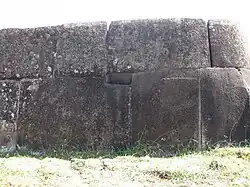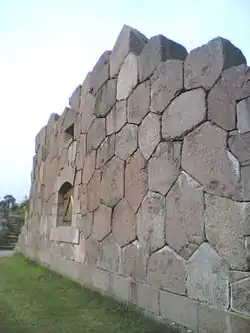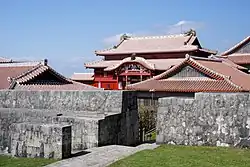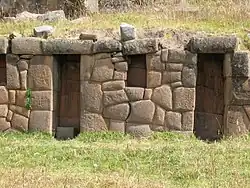Polygonal masonry

Polygonal masonry consists of stones that have five or more face angles, in contrast to ashlar blocks which have four rectangular ones.[1]
In Greece, Cyclopean masonry was the first type of polygonal masonry.[2] To fit the stones properly to each other, masons would utilize strips of lead to form templates of the already laid blocks, which were then used to shape the to-be-adjoined ones.[3]
Sites
Easter Island

Finland

Greece

Italy
In Italy, polygonal masonry is particularly indicative of the region of Latium, but it occurs also in Etruria, Lucania, Samnium, and Umbria; scholars including Giuseppe Lugli have carried out studies of the technique.[4][5] Some notable sites that have fortification walls built in this technique include Norba, Signia, Alatri, Boiano, Circeo, Cosa, Alba Fucens, Palestrina, and Terracina.[6] The Porta Rosa of the ancient city of Velia employs a variant of the technique known as Lesbian masonry.[1]
Japan

- Akō Castle
- Fushimi Castle
- Nakagusuku Castle
- Nijō Castle
- Odawara Castle
- Oka Castle
- Osaka Castle
- Shibata Castle
- Shuri Castle
- Uwajima Castle
Latvia
Malta
Peru

- Chinchero
- Chullpa Towers
- Coricancha
- Inti Watana, Ayacucho
- Ollantaytambo
- Raqch'i
- Saksaywaman
- Tambomachay
- Tarawasi
- Usnu
- Vilcabamba
- Vilcashuamán
- Wanuku Pampa
- Twelve-angled_stone
Portugal
Russia
Spain
Turkey
United Arab Emirates
References
- ^ a b G.R.H. Wright (23 November 2009). Ancient Building Technology, Volume 3: Construction (2 Vols). BRILL. pp. 154–. ISBN 90-04-17745-0.
- ^ Carmelo G. Malacrino (2010). Constructing the Ancient World: Architectural Techniques of the Greeks and Romans. Getty Publications. pp. 97–. ISBN 978-1-60606-016-2.
- ^ Scranton, Robert L. (1941). Greek walls. Harvard University Press. p. 27. ISBN 9780598572547.
{{cite book}}: ISBN / Date incompatibility (help) - ^ Frank, T. 1924. "Roman buildings of the Republic: an attempt to date them from their materials." MAAR 3.
- ^ Giuseppe Lugli (1957). La Tecnica Edilizia Romana Con Particolare Riguardo a Roma E Lazio: Testo. 1. Johnson Reprint.
- ^ Jeffrey Alan Becker (2007). The Building Blocks of Empire: Civic Architecture, Central Italy, and the Roman Middle Republic. ProQuest. pp. 109–. ISBN 978-0-549-55847-7.
- P. Gros. 1996. L'architecture romaine: du début du IIIe siècle av. J.-C. à la fin du Haut-Empire. 2 v. Paris: Picard.